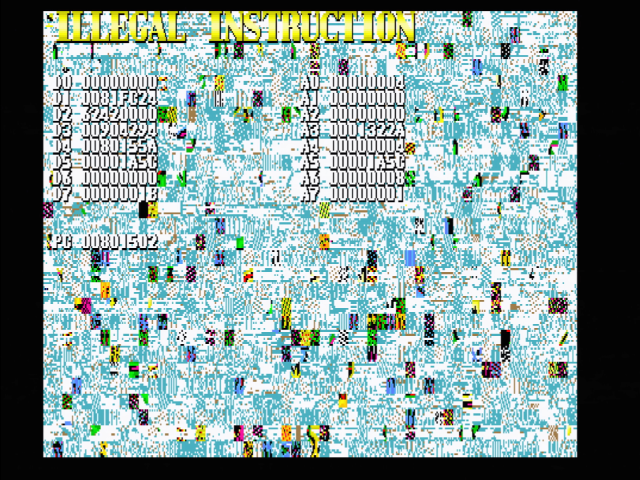The IGS PolyGame Master: A Even More Neo Geo?
Imagine, if you will, a four-button JAMMA arcade board that took large plastic-clad cartridges that had two PCBs inside. With a powerful Motorola 68000 processor, and a Zilog Z80 alongside to handle sound duties, with a powerful chipset allowing for colorful 2D graphics with scaling of sprites. Hailing from an island in the Pacific off the east coast of Eurasia. Great, so we’re on the same page– wait, what the heck is a Neo Geo? That’s not what I was talking about at all!
2D isn’t dead yet
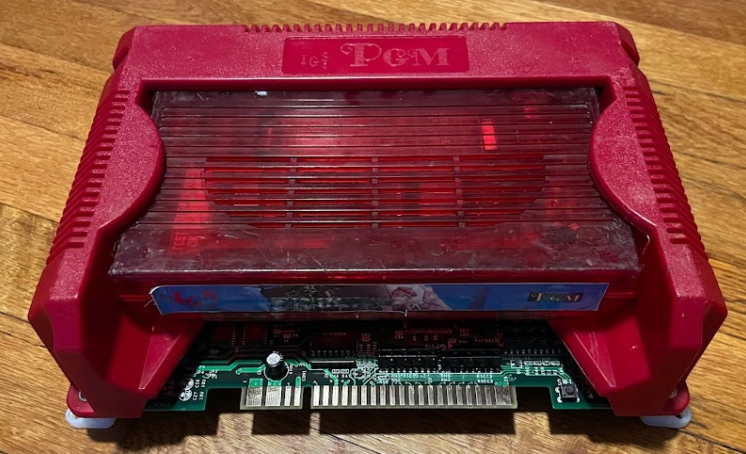
The PolyGame Master was released in 1997 by Taiwanese-based company International Games System (IGS). And yes, from the exterior, it looks a lot like the famous SNK Neo Geo from 7 years earlier. But let’s take a look inside. A lot changed over the past seven years, after all.
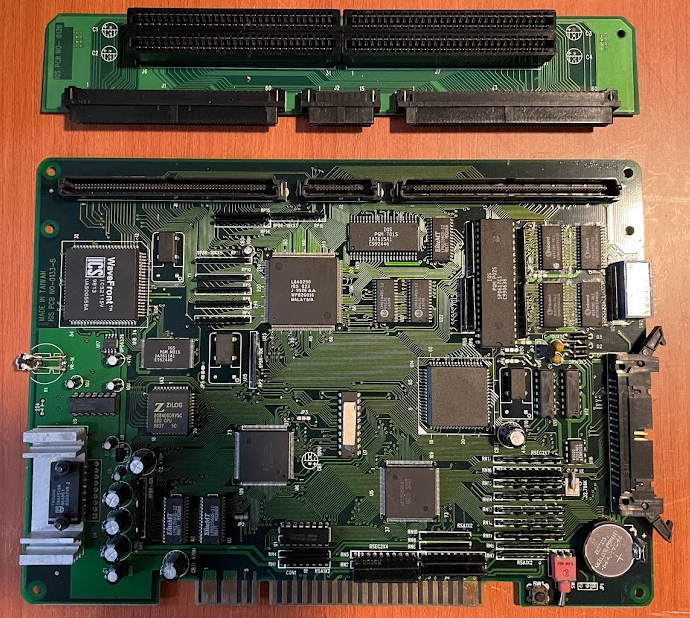
The Motorola 68000 is an interesting choice of CPU, definitely a bit long in the tooth by this point. On the other hand, though, it was well-understood, affordable, and in 1997 newer production methods made it possible to run much faster. Whereas the 1988 Sega Genesis had a 7.6MHz, and the 1990 Neo Geo only sported a 12MHz 68000, this surface-mount chip here runs at a whopping 20.000 MHz.

The Zilog Z80 was even more long in the tooth by 1997. At 8.468MHz, this one runs twice as fast as the Neo Geo, but it’s also got a different job: rather than running a Yamaha YM2610 synthesizer, this one runs a WaveFront ICS2115V, which can run up to 32 sampled audio channels (called “wavetable”) and used in many PC MIDI cards. Judging by the datasheet, it was designed to interface with a Motorola 68EC000 CPU, so the use of a Z80 here is very likely a cost-cutting move. Not a bad one, though; the Z80 was a well-understood animal by arcade programmers in the 1990’s.
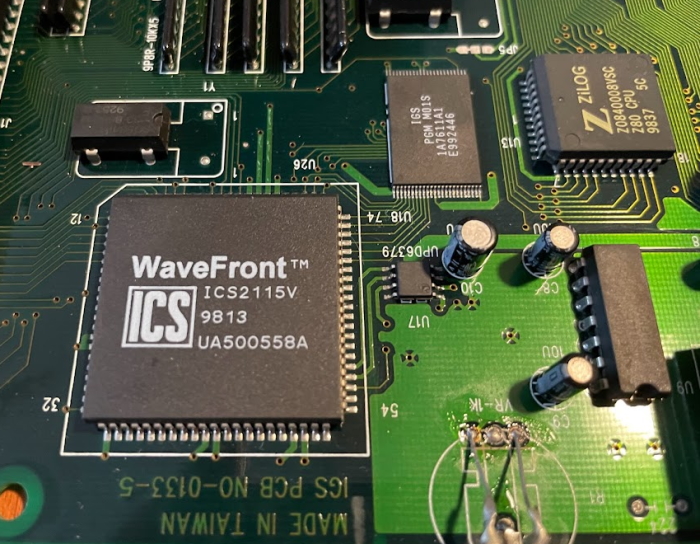
The graphics of the IGS PGM are also a modest upgrade over the Neo Geo, with the capability of zooming, not just shrinking, sprites, as well as a background tilemap in addition to the overlay. It seems to use a 15-bit RGB rather a 16-bit like the Neo Geo, but other than that it’s a nice spec bump. It even has 5bpp art– 32 colors per sprite (including transparency), rather than the Neo Geo’s 16 (4bpp).

The PolyGame Master is a low-cost interchangeable-cartridge based system with excellent 2D graphics and sound capability. Certainly in 1997 the high end of the market had moved to 3D, even SNK was trying to, but IGS judged there was still more room at the bottom of the market. And given the success of the system, they weren’t wrong.
Cartridges
Here’s the inside of one of my PGM cartridges. This isn’t the game shown in the system above (we’ll talk about that, game, DoDonPachi DaiOuJou Black Label, later); it’s Oriental Legend, a 1997 title that seems to be one of the most affordable for the console, as well as the most common– I believe it was a launch title for the system. It’s also the only cartridge I have that has an opaque red shell rather than a translucent red one.

The large chip labeled “IGS 003C” seems to be a combination between an 8255 PPI and a protection chip, used in prior IGS systems. My assumption here is that it’s only being used for a protection chip. Like with later Neo Geo titles, conversions of IGS PGM games were rampant, and protection chips grew increasingly elaborate over the system’s life. Here’s 2001’s DoDonPachi II, one of the best titles on the system. I think this board is legitimate, but it’s definitely been opened a few times.
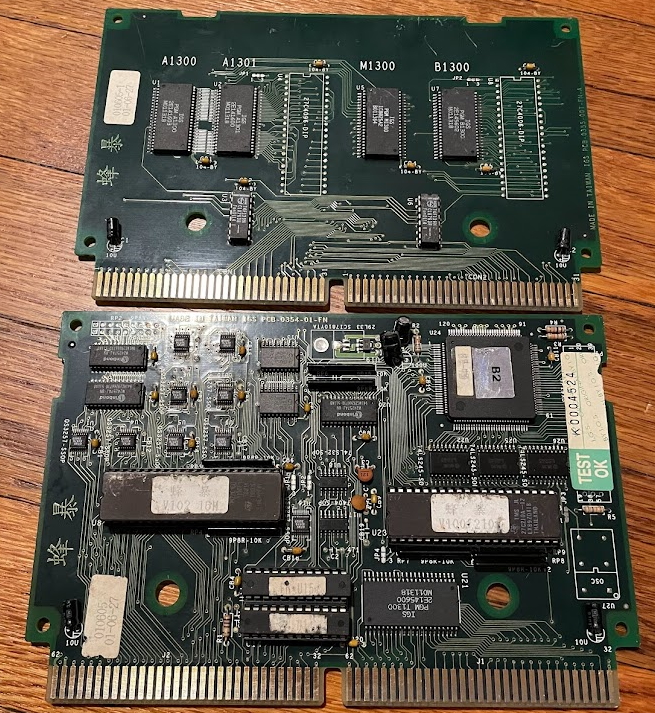
The large chip labeled “B2” is, according to research done elsewhere including as part of the MAME project, a ARM7TDMI core– comparable to the 2001 Nintendo Game Boy Advance, with an internal ROM used for protection purposes. Which would imply it’s more powerful than the 68000 running the show. Very nice!
Widescreen
If you open up MAME and take a screenshot of Oriental Legend, you might get to see something like this:
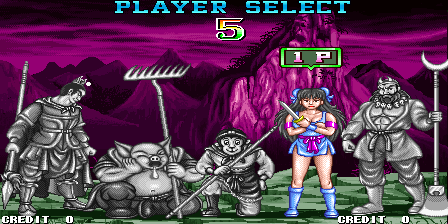
The resolution of the IGS PolyGame Master is 448x224. By comparison, the Neo Geo is 320x224, and the “high-resolution” mode of the PC Engine can be as wide as 512x224. But these would all be displayed on standard 4:3 resolution monitors (or televisions, in the case of the Neo Geo home systems and the PC Engine). The pixels are just nowhere near square.

Take a look at the “CREDIT” text in the bottom; it looks vertically stretched in my capture, but you can look at MAME to see it’s just taking up 8x8 PGM pixels. Drawing art with very non-square pixels isn’t easy; originally I wanted to use 512-pixel wide mode in Space Ava 201 and gave up because drawing the art was too much effort. (Admittedly, it did also free up VRAM for more characters on screen at once) So kudos to IGS and their developers.
All cats are good, even copycats
Looking online I honestly think the IGS PGM gets a bad reputation. As a Taiwanese company, it often gets accused of copying the competition systems. For example, Demon Front is a very fun little run-and-gun.

Is it a clone of Metal Slug? I wouldn’t say so. Sure, it shares a lot of elements, but it also adds new gameplay elements like the players’ pets that can provide protection, and the art is beautiful. It’s definitely a game that can be appreciated on its own merits– Metal Slug does Metal Slug better, though. This isn’t just a system for clones.
Okay, now that we’ve got that out of the way… let’s take a look at some clone stuff! Here’s a cartridge that claims to be an enhanced version Knights of Valour. This is a fighting game series loosely based on the Romance of the Three Kingdoms, and is one of the most popular game series for the console, with IGS making a number of remade versions.
But I don’t think IGS had the license to put Iori Yagami in there. In fact, I don’t think IGS did this at all.

Yep, despite all those increasingly elaborate protection chips, just like on the Neo Geo, PGM games got cloned, hacked, and all of that. Rampantly so. This game here isn’t even a “conversion”, as you’d often see. While I have no doubt the heavily worn translucent red shell is probably real, the boards inside are dated 2009 and 2010, well after the end of IGS’s support for the system. They’re also a very classy red to match those shells, which is a nice touch.
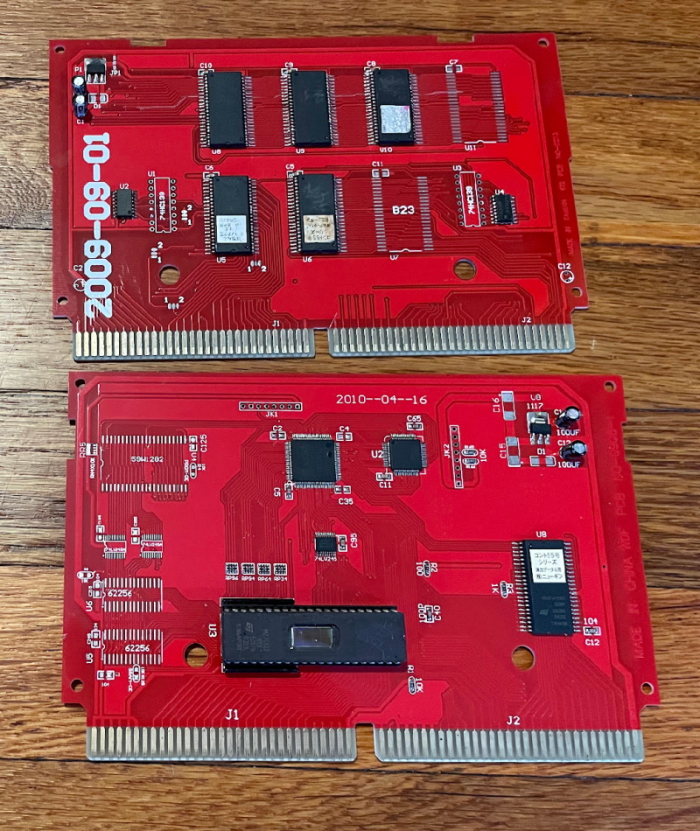
Of course, the massive numbers of clones and conversions out there, along with the fact that the best website for finding PGM carts these days seems to be Aliexpress, makes the market a severe case of caveat emptor. Indeed, I wouldn’t be surprised if some of the other games I’ve listed here are fake, though they look real enough to me. But clone boards like this are part of the PGM experience.
Who wants real games anyway?
I mentioned above DoDonPachi II. Despite bearing the same name as CAVE’s famous DoDonPachi, it’s an IGS production, licensing the title. It seems to have also been a “proof of concept” of sorts, proving the PolyGame Master could serve as a successor to CAVE’s aging Motorola 68000-based hardware.
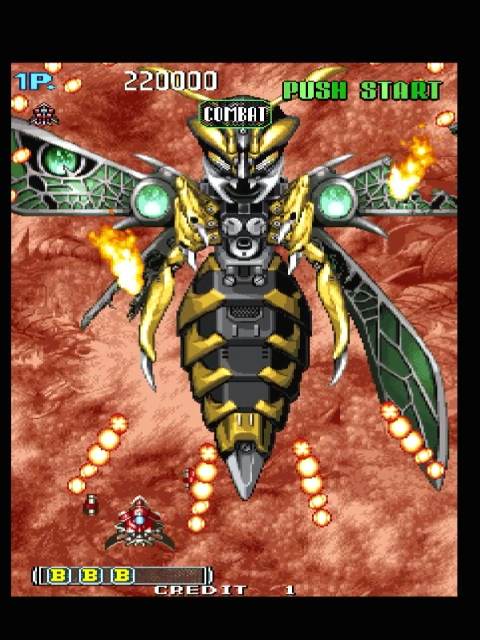
In the end, the low cost and the familiar CPU won out, and CAVE would produce three titles using the PolyGame Master:
- DoDonPachi DaiOuJou (2002)
- Ketsui: Kizuna Jigoku Tachi (2003)
- Espgaluda (2003)
However, these three games, though they used PGM chipsets, were not released as standalone cartridges. They were specifically designed to break in the presence of the PGM BIOS, and were instead released as standalone JAMMA circuitboards using the same chips as the PolyGame Master. Like many CAVE PCBs, they are now quite rare and pricy. I don’t have them.
But yet, I can still play this game:
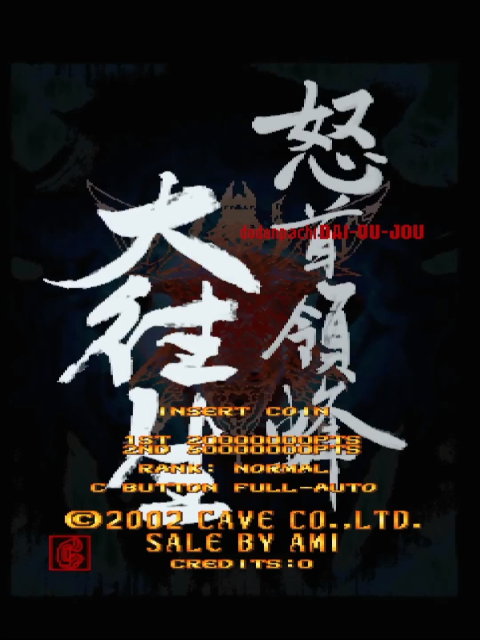
See, by this point the hacker side of the market knows the PolyGame Master inside and out, and were able to hack the CAVE titles to work on cartridge. (I occasionally see online claims that there were limited official cartridge releases in China, but at the moment I’m not convinced that’s true; I suspect it may be a confusion with the PGM2 version I’ll discuss later) In this case, it is the very rare “black label” version, which only had 100 official copies. The black label would’ve been the basis for the cancelled western release DoDonPachi III.
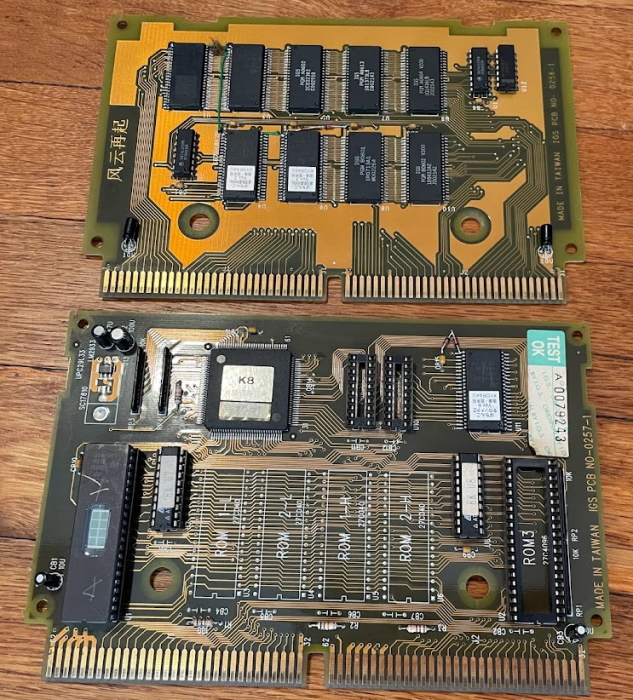
I can’t find any information on what games IGS PCB NO-0257-1 and IGS PCB NO-0256-1 were, they’re not listed on the igspgm.com listing. Whichever game they were once, the PCBs seem to not have required significant rework for this case.
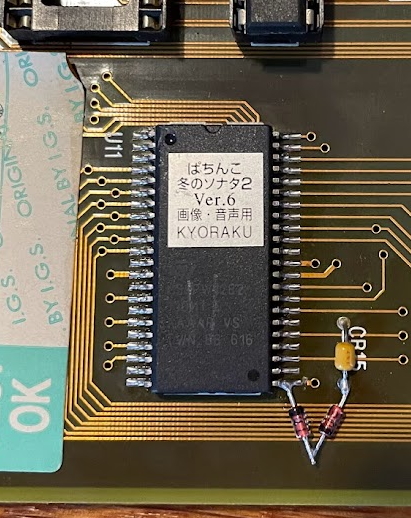
I can at least say that it looks to be using chips scavenged from a pachinko machine. “Pachinko Winter’s Sonata 2”, if my translation is correct.
More Poly, More Game
The PolyGame Master was a moderate success, releasing games up to 2005. (And in case you’re wondering, the Motorola 68HC000 used was still produced new up until 2010! Chips can have a surprisingly long life) But it made sense that a successor would be needed; not only was the hardware aging, the protection chips were generally broken and game copies were rampant.
So behold: the IGS PolyGame Master 2. I only have one game, DoDonPachi DaiOuJou Tamashii. I’ve pictured it next to the PlayStation 2 release, so you can see the difference between what arcade operators want in a box art, and what consumers want to see. Maybe.
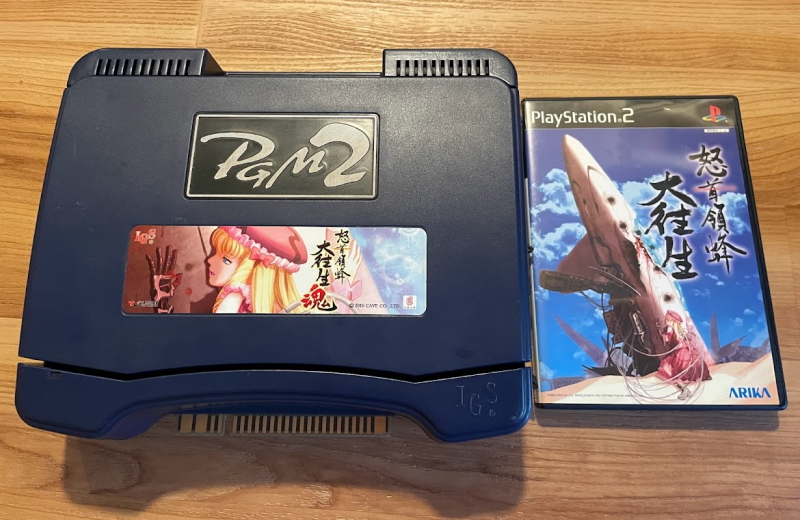
In my experience looking around, it’s fairly uncommon to see loose PGM2 games for sale; generally, they’re sold as combined sets, the cartridge mated with a JAMMA adapter. But don’t be fooled by the smooth plastic shell. This is a cartridge; and one with enough connectors to make even the Hyper Neo Geo 64 proud. No wonder SNK (by now, SNK Playmore) would go on to release a game for this system.

If you crack open the PGM2 and its cartridge, you might notice something: the cartridge board is awfully busy, with even a battery for storing settings, whereas the PGM2 body is fairly empty, with most of the components on the circuitboard being heavily integrated.
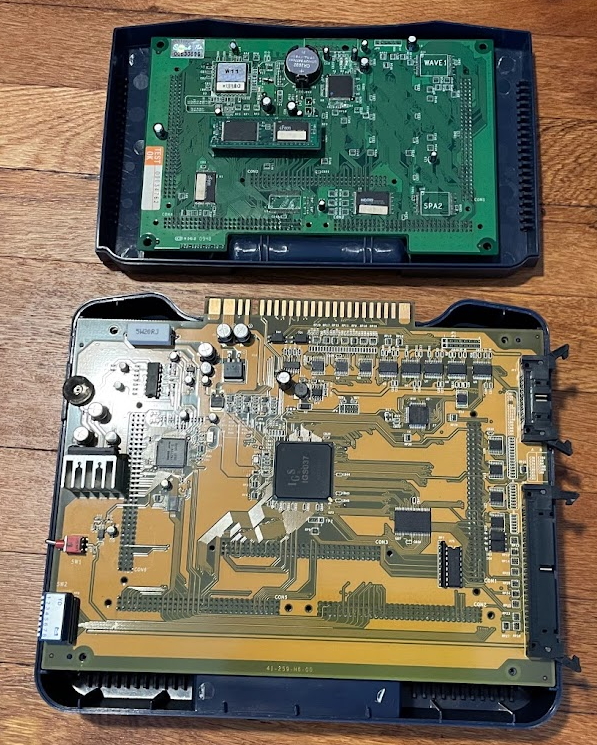
The PGM2 follows in a fairly rare list of interchangeable-cartridge arcade systems that place the CPU on the cartridge. The CPU in this case (beneath the ‘W11’ sticker) is an ARM core with an embedded ROM, very similar to the protection chips mentioned above, but now running the show.
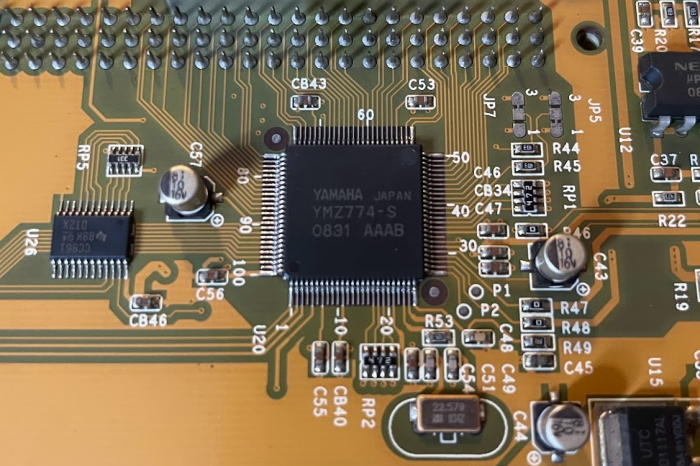
Don’t assume this means that the lower half does nothing, however. The IGS037 contains the integrated graphics processor, and the lower half also contains the sound circuit, built around a Yamaha YMZ774-S, part of the YMZ770 “AMMS” series. In this case, it is able to mix four channels. Since this is standard JAMMA, it also contains an amplifier.
Unfortunately, DoDonPachi DaiOuJou Tamashii is probably not the best game to show off the PGM2: it’s very similar to its predecessor. PGM1 Black Label on the left, PGM2 Tamashii on the right.
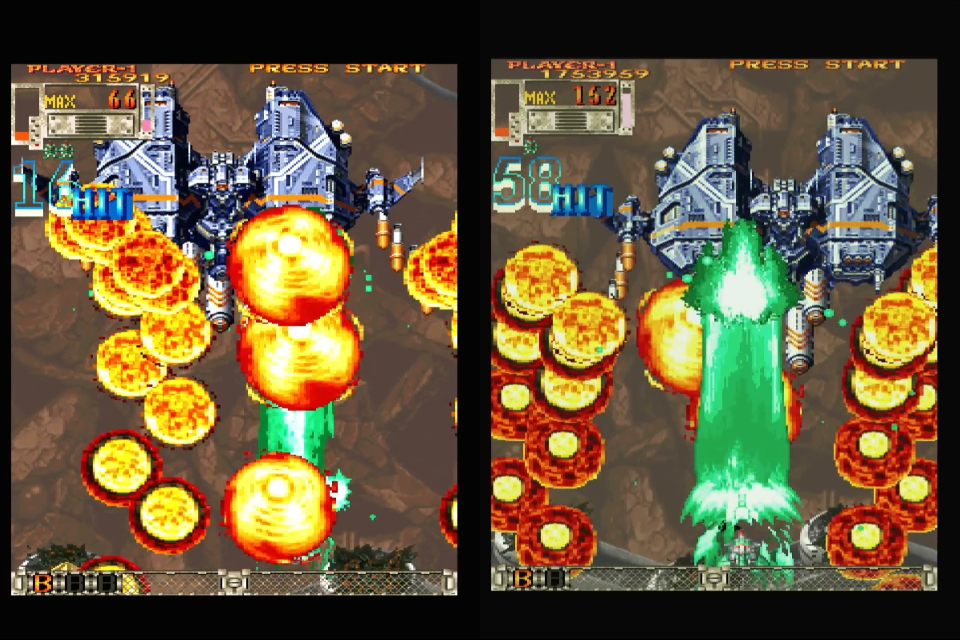
Perhaps there is a difference in the colors? The PGM2 has 24-bit RGB as opposed to the 15-bit RGB of the PGM1, and the colors appear to be slightly richer on the newer system. Overall though, CAVE and IGS seem to have focused primarily on producing a similar experience to the original machine– so original, in fact, that though Tamashii also features an easy mode, it does not feature the Black Label’s single-loop mode.
Getting dangerously close to the present
The PGM2 has seven titles listed on Wikipedia, and doesn’t seem to have been anywhere near as successful as the PGM1. It was succeeded in 2012 by the IGS PGM3, which was PC-based (though still with a JAMMA edge), and only got a single game: Knights of Valour 3. They don’t list it on their website anymore, so it’s probably safe to say the PolyGame Master line is over.
I think it’s a pretty worthy addition to my collection, though I have to admit, I’d prefer if the first one I got worked. It seems to run pretty well in MAME, and hopefully a MiSTer core or other options will be available soon as well. After all, though I find this system pretty fun to play, it’s definitley not aging well.
